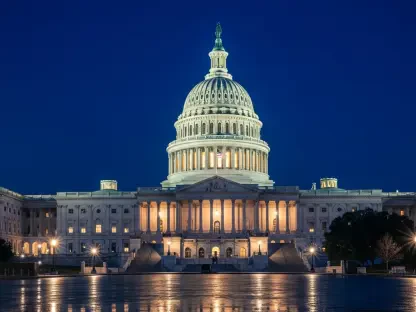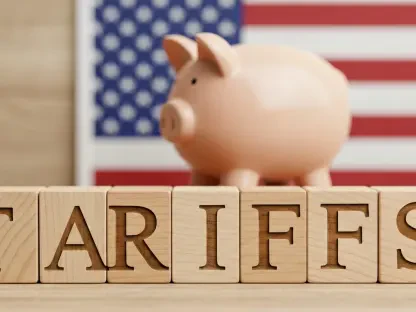Could strategic global alliances hold the secret to revitalizing a stagnant economy? Former President Donald Trump’s impending visit to the Middle East might provide an answer, offering possibilities to inject fresh investments that could rejuvenate various sectors of the United States economy. As Trump rekindles relations with Middle Eastern nations, there’s noteworthy curiosity—is aligning economic interests with political investments the pathway to economic renaissance?
The potential for new economic alliances with Middle Eastern countries is significant, as seen through the planned trip by Trump. In pursuit of stimulating the U.S. economy, these ties might open avenues for substantial foreign investments. Central to this discussion is the involvement of the Committee for Foreign Investment in the United States (CFIUS) and its role in evaluating foreign investments within the real estate market for security risks. The narrative unfolds amid broader talks aiming to expedite foreign capital flows into the U.S., leveraging partnerships fostered during Trump’s presidency.
The Crucial Role of Foreign Capital
Middle Eastern countries like the United Arab Emirates, Saudi Arabia, and Qatar have emerged as pivotal players in international investment dynamics. Their substantial financial reserves are increasingly directed toward foreign markets, including the United States. Sovereign wealth funds from these nations represent commitments to large-scale investments that promise to bolster economic growth. As global economic trends shift, these strategic allocations might transform industries such as artificial intelligence and renewable energy.
Investments from these regions offer considerable prospects for U.S. economic expansion. The UAE has pledged $1.4 trillion across various sectors, highlighting ongoing collaborations with the U.S. Saudi Arabia’s commitment of $1 trillion further illustrates the profound impact these alliances can have on economic revitalization. Qatar’s emphasis on real estate and technology investment not only generates opportunities but also brings substantial benefits to the U.S. market, promising advances in these sectors.
Scale and Scope of Investments
The magnitude of investments pledged by Middle Eastern nations is noteworthy. With $1.4 trillion from the UAE targeting areas like AI and energy, these partnerships are poised to drive significant economic activity. Saudi Arabia’s $1 trillion pledge underscores its strategic alignment with the U.S. Amid this surge, Qatar continues to solidify its focus on real estate and technology, manifesting successful outcomes seen with projects like luxury resort development and software innovation.
These strategic investments have transformative potential for U.S. industries, fostering innovation and competitiveness. Real-world examples illustrate this trend, such as Qatar’s recent technological ventures that have created ripple effects across various sectors. Such collaborations reflect broader strategic ambition, leveraging existing ties and nurturing future ones to harness economic growth.
Navigating Ethical Complexities
Despite the promising economic outcomes, ethical dilemmas linger. Trump’s business dealings in the Middle East present potential conflicts of interest, bringing these partnerships under scrutiny. With Trump’s real estate ventures currently underway in several regions, the boundaries between his business interests and political roles blur, posing ethical challenges highlighted by groups like Citizens for Responsibility and Ethics in Washington.
Insights from watchdog organizations emphasize accountability, urging transparency in these dealings. The intersection between Trump’s dual roles necessitates a closer examination of ethical frameworks and potential bias that could emerge from such high-stakes engagements. This complexity requires navigating a landscape where business pursuits and political alliances converge.
Expert Perspectives on Economic Impact
Economic analysts and political commentators offer valuable insights into the repercussions of Trump’s Middle Eastern engagements. Long-term impacts of these relationships could reframe economic strategies and redefine the U.S.’s position in global markets. International business experts weigh in on the implications, stressing the intricate balance required in navigating political-economic landscapes.
These alliances could bolster the U.S. economy, yet the trajectory depends on strategic foresight and comprehensive planning. As experts unravel the complexities of cross-border relationships, they suggest pragmatic approaches and proactive policies to harmonize economic interests while maintaining ethical integrity.
Toward a Transparent Investment Framework
Strategic management of international investments seeks mitigation of conflicts of interest. Encouraging transparency and ethical conduct in these alliances becomes imperative, with policies designed to foster accountability and impartiality in foreign capital flows. Industry reforms propose frameworks that ensure fairness while safeguarding national interests.
By advancing such reforms, the U.S. can optimally harness international investments, promoting sustainable growth. A future-oriented approach, combined with stringent oversight, offers pathways to capitalize on global economic opportunities while ensuring ethical adherence in cross-border dealings.
The exploration of Trump’s Middle Eastern ties reflects a broader narrative on leveraging geopolitical relationships for economic gain. Despite historical and ethical complexities, these engagements harbor potential economic incentives that could sculpt U.S. foreign policy and economic strategies. Ultimately, the outcome relies on implementing innovative measures to secure investment integrity and stimulate economic vitality.









